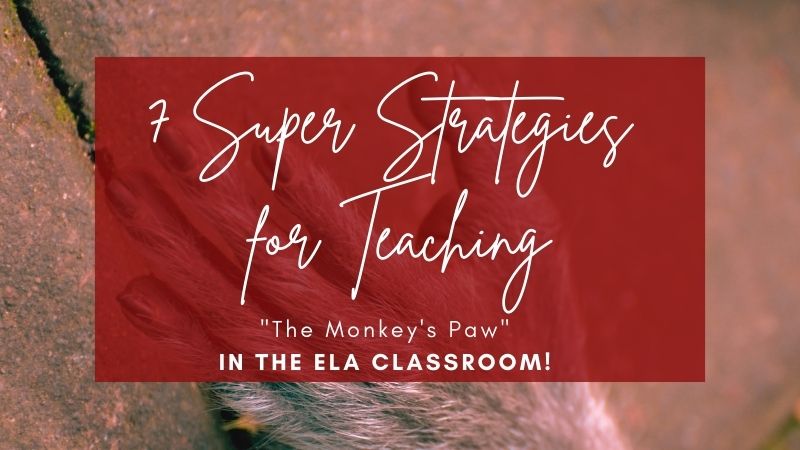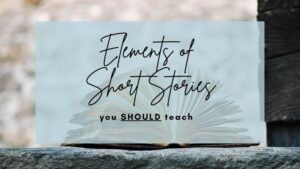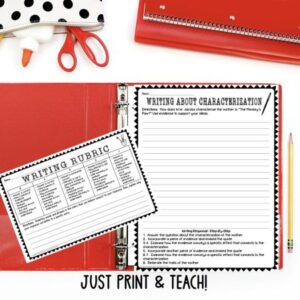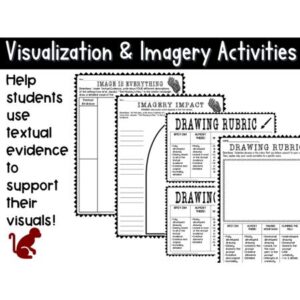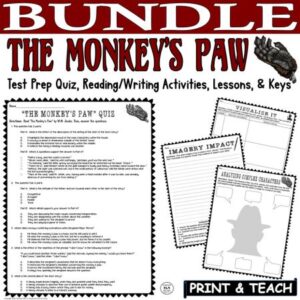Do you need a spooky story to teach during the Halloween season, your short story unit, or at the end of the year when you are just DONE with your upper middle and younger high school students? Check out “The Monkey’s Paw” by W.W. Jacobs! This short story tells the tale of a couple who experiences the untimely death of a loved one and uses three wishes to ask for what they think they want. The end is quite unexpected…and horrifying!
Keep reading for 7 Super Strategies for Teaching “The Monkey’s Paw!”
Need help with teaching what reading strategies will work while using Test Prep? Check out this FREE Pack of 3 Test Prep Activities to help students achieve success on standardized tests!

7 Super Strategies for Teaching “The Monkey’s Paw”
1. Focus on the Setting
The setting plays a significant role in the story from start to finish. So choosing to focus on the setting is a good place to begin teaching “The Monkey’s Paw!”
Setting is the description of the time and place. Let’s look at the very beginning of this story:
Without, the night was cold and wet, but in the small parlour of Laburnam Villa the blinds were drawn and the fire burned brightly. Father and son were at chess, the former, who possessed ideas about the game involving radical changes, putting his king into such sharp and unnecessary perils that it even provoked comment from the white-haired old lady knitting placidly by the fire.
You could start your students off by reading this paragraph, underlining words that connect to the setting, and examining the effect of the words!
Here are some examples to start off your students’ analyses:
- Ex. “night was cold and wet” – Typically, this language evokes sadness, horror, or loneliness; the family, however, is playing games and having an enjoyable time.
- Ex. “small parlour” – This location depicts a normal, comfortable, familial setting.
- Ex. “fire burned brightly”-These words have more positive connotations with brightness and light.
Need more help with teaching short stories? Check out this post below for teaching elements of short stories!
2. Focus on Characterization
In the process of teaching characterization, you may want to follow these steps:
- Explain the concept of character traits. Every person has external (physical) and internal (emotional, mental, spiritual) traits. If you have students identify their own external and internal traits first, the process of teaching types of characterization will be MUCH easier!
- Define direct and indirect characterization. Direct characterization refers to what is directly said in the narration/description concerning the character. Indirect characterization uses actions, words, and events in order to characterize the character(s). After explaining these concepts, connect back to the students’ own traits. What is directly said about them by family, friends, teachers, coaches, etc.? What traits are revealed through your students’ actions, words, and events?
- While students are reading, you could guide them in analyzing characterization throughout the beginning, middle, and end of “The Monkey’s Paw.” They could choose to analyze the traits of one or both of the parents!
Want help with teaching character traits for “The Monkey’s Paw?” Click the image below!
3. Focus on the Plot
Identifying plot elements might seem super basic, but for older stories with higher-level language, this process is super helpful. Sometimes, there is no absolutely right or wrong answer for each element; as long as students have evidence and explain their responses, that is the ultimate goal!
Terms to Introduce and/ or Review:
Exposition: the introduction to the characters, setting, and conflict; helps to set the stage for the reader
Rising Action: action that takes place after the exposition and leads up to the climax; develops the characters and builds suspense
Climax: the most important part of the story; the highest point of action that causes a change in some way
Falling Action: action that takes place after the climax; leads to the resolution
Check out this plot elements pack to make teaching the plot for the short story “The Monkey’s Paw” much easier!
4. Focus on Imagery
Imagery is defined as language that connects to the five senses: sight, sound, taste, touch, and smell.
Too often, students only notice descriptions related to sight, but imagery can be so much more! Because our culture is inundated with images, we need our students to see the varying purposes of imagery.
Here are the last paragraph and imagery analysis ideas from Part 1 of “The Monkey’s Paw:”
He sat alone in the darkness, gazing at the dying fire, and seeing faces in it. The last was so horrible and so simian that he gazed at it in amazement. It got so vivid that, with a little uneasy laugh, he felt on the table for a glass containing a little water to throw over it. His hand grasped the monkey’s paw, and with a little shiver he wiped his hand on his coat and went up to bed.
Touch: Ex. “His hand grasped the monkey’s paw, and with a little shiver he wiped his hand on his coat and went up to bed.” This description highlights this character’s fear associated with the monkey’s paw and foreshadows impending events.
Sight: Ex. “He sat alone in the darkness, gazing at the dying fire, and seeing faces in it.” As the character sees “faces” in the dying fire, the reader should understand that there will be a death coming soon with this description of upcoming doom.
Click below to get print and teach activities for “The Monkey’s Paw!”
5. Focus on the Mood
Mood is the emotion brought about by the description and events in the story. What is tough about this concept is the vocabulary students need to identify the mood. We don’t want to see “bad,” “good,” or “neutral” in their responses.
We want students to get specific. Let’s take a look at this excerpt from Part 2 of “The Monkey’s Paw.”
In the brightness of the wintry sun next morning as it streamed over the breakfast table he laughed at his fears. There was an air of prosaic wholesomeness about the room which it had lacked on the previous night, and the dirty, shriveled little paw was pitched on the side-board with a carelessness which betokened no great belief in its virtues.
Clearly, the author is trying to throw off or disarm the reader by providing a sense of relief or lightheartedness after the end of Part 1. So we see a shift in mood from one of fear to ease. Of course, the author uses this shift to illustrate how people can change perspectives from the darkness of night to the brightness of morning.
An easy activity for your students might be to offer them 3 excerpts to analyze. They can identify the mood, use evidence to support their ideas, and explain why the author incorporated each mood!
6. Focus on the Diction
Diction is simply word choice, but we really want students to get specific as they use the word diction. I like connecting the diction to a tone word. Otherwise, you will have students saying that “The author uses diction…” Um yeah, so the author is using words. Thank you!
We could use the following examples based on the word choice near the end of the story:
Ex. heartbreaking diction, horrified diction, mortifying diction
She broke off as the sinister meaning of the assurance dawned on her and she saw the awful confirmation of her fears in the others averted face. She caught her breath, and turning to her slower-witted husband, laid her trembling hand on his. There was a long silence.
“He was caught in the machinery,” said the visitor at length in a low voice.
There are so many words that contribute to the tone/diction: “sinister,” “awful,” “fears,” “trembling,” “silence,” “caught,” and “low.”
After students notice the tone is positive or negative, help them to get a bit more specific! Specificity is key to analyzing tone and diction!
7. Focus on Literary Devices
After defining the following concepts, you could encourage students to find evidence for each literary device in the story! Remember, you don’t have to have students analyze EVERY literary device; pick and choose 2 or 3 concepts to teach!
Here are some literary devices and/or elements you could focus on as you guide your students through this story:
Foreshadowing- events, dialogue, or descriptions that offer hints to later happenings in the story/text
Symbolism- images, objects, or even people that represent an idea
Irony- outcomes with unexpected/opposite results
Why should you teach “The Monkey’s Paw?”
- Students are engaged almost immediately with the introduction of the monkey’s paw!
- The language, although difficult at times, will challenge ALL of your students in some way.
- There are so many strategies and concepts you can focus on as you teach this story!
- You could thematically link this story to other short stories that have a twist or surprise ending.
Check out the BUNDLE below for EASY-TO-TEACH lessons and activities for “The Monkey’s Paw!!”
Want more ideas, lessons, or activities for teaching The Monkey’s Paw? Check out my store Kristin Menke-Integrated ELA Test Prep!

